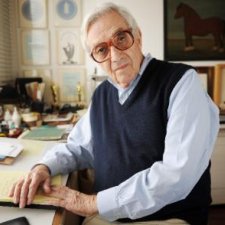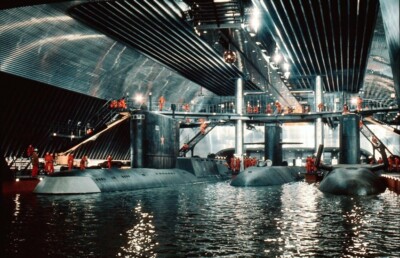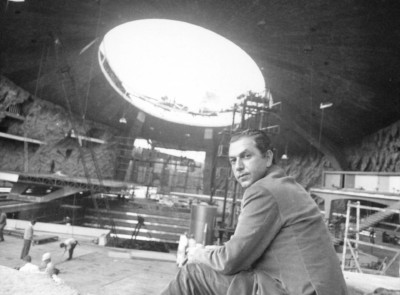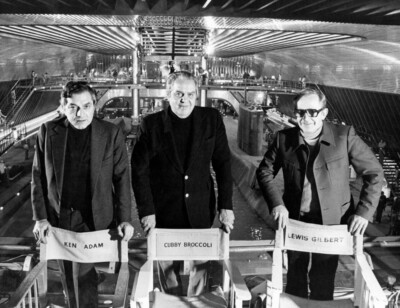 Now pay attention, 007. One morning Ken Adam, a former pilot himself, was listening to the radio and he heard the inventor and ex-RAF pilot Wing Commander Ken Wallis talking about his autogyro helicopter. Adam suggested to EON that this machine could be put into You Only Live Twice, and it famously became ‘Little Nellie’ in the movie. It proved to be a great suggestion and was typical of the man renowned for his visual creativity in films.
Now pay attention, 007. One morning Ken Adam, a former pilot himself, was listening to the radio and he heard the inventor and ex-RAF pilot Wing Commander Ken Wallis talking about his autogyro helicopter. Adam suggested to EON that this machine could be put into You Only Live Twice, and it famously became ‘Little Nellie’ in the movie. It proved to be a great suggestion and was typical of the man renowned for his visual creativity in films.
The artistic work of production designer Sir Ken Adam (1921-2016), now famous in cinema history for his iconic designs for the James Bond films in the 1960s and 1970s and for numerous other non-Bond films, has been celebrated in a major new volume entitled The Ken Adam Archive. Taschen’s new book captures the sheer variety and enormity of Sir Ken’s creative imagination, and rightly so. The exciting volume explores in comprehensive detail the artistic and production designs of Sir Ken over the whole of his career, and includes visual imagery from the veteran designer’s own personal collection of material, accumulated over long years of working in the movies.
Interestingly, towards the end of his life, Sir Ken was increasingly aware of how much inspiration he had given to rising design stars in the field, and became keen to leave an archival legacy for others to use and also enjoy. In 2012, Sir Ken therefore donated his entire artistic and design output to the Deutsche Kinemathek in Germany, a collection which includes over 4,000 drawings, various storyboards, many photographs from movie sets, numerous personal documents, and a large number of design sketches, including his designs for all the work he carried out on his James Bond movies, up to and including Moonraker (1979).
From a View to a Thrill
The Deutsche Kinemathek subsequently made the Ken Adam collection initially available via an online inventory in the Summer of 2015, and the collection has since become an invaluable resource for both film historians and design scholars. The new volume, published by Taschen in a limited edition run of 1,200 and retailing at an eye-watering £850, draws on the archive for key material, as well as other Adam images.
In fact, for those who want a readily accessible coffee-table style book, Taschen’s new 360-page volume, which has a commentary by Sir Christopher Frayling, functions as the next best thing to the Deutsche Kinemathek collection and, if you can borrow a gold bar or two from Auric Enterprises, it is a highly worthy celebration of the incredible visual impact Sir Ken had on movies. Once dubbed the ‘Man with the Midas Touch’ by one UK newspaper, the late Sir Ken has become something of a legend among Bond film aficionados across the globe and, for many years, was arguably one of the British film industry’s pre-eminent production designers.

As Sir Roger Moore observed in his book Bond on Bond in 2012, Ken Adam’s ‘sloping roofs, gigantic sets and wonderful blending of the futuristic and classic was revolutionary’. On Goldfinger, for example, as Roger noted, Sir Ken’s ‘fictionalized vision of the interior of Fort Knox caused the American authorities to question their obvious breach of secuity – even they thought it was real’. Significantly, Bond co-producer Cubby Broccoli also pointed to the Fort Knox set as a highly special moment in the Bond franchise’s design history. In his memoirs, When the Snow Melts (1998), Cubby said that Ken Adam’s concept of what the inside of the Fort Knox depository supposedly looked like ‘was close to genius’. Similarly, when recalling the making of The Spy Who Loved Me (1977), the EON producer said Ken Adam’s set designs ‘were masterly’, the gem being the Liparus, Stromberg’s supertanker, for which they had to construct at Pinewood Studios what became (at the time) the biggest film stage in the world.
Plenty of other production and set designers have regularly pointed to Sir Ken’s exemplary work as inspiring their own designs over the years, while the veteran designer also built up a significant fan-base among both mainstream and modernist architects. In 2013, for example, in a special BBC Radio-3 documentary profile of Ken Adam, it was revealed that the award-winning top architect Norman Foster was a big fan of Sir Ken’s work. At one point in the documentary, the former 007 designer was especially stunned to discover that Foster’s design for the new German parliament building had been influenced by the Adam design ‘look’.
Designer Royale
German-born Ken Adam was a Jewish refugee from Nazi Germany and served as a pilot in the British RAF in World War Two. He originally trained to be an architect. But the world of film offered numerous possibilities, and Adam once commented that movie-set work, while often enormously challenging, could be deeply satisfying when it went well.
And, clearly, it had gone extremely well for Adam over the decades. He was nominated for many awards over the years, including for his set designs on the James Bond movies, and also picked up BAFTA Awards for Dr. Strangelove (1964) and The Ipcress File (1965). He also held two Academy Awards: for Barry Lyndon (1975) and The Madness of King George (1994). In 2011, in celebration of his 90th birthday (he had turned 90 in February, 2011), Sir Ken was also given a special BAFTA Tribute for his services to film.

Prior to his death in 2016, Sir Ken gave many interviews about his work over the years. These highlighted his ground-breaking designs for the 007 franchise and other movies. He was especially pleased that he had won the approval of Stanley Kubrick, the director of Dr. Strangelove (1964), for which he had designed the now iconic ‘War Room’. It is said that when Ronald Reagan became president, and was shown around the Pentagon, he had asked where the ‘War Room’ was, and was disappointed to learn it did not actually exist.
But Adam was always modest about his own contribution to the film world. When interviewed by The Times in 2011, for example, the paper suggested to him that his lush and extravagant sets, such as the volcano rocket base in You Only Live Twice (1967) and the submarine-swallowing supertanker in The Spy Who Loved Me (1977), had really defined the mood of the entire 007 series. Sir Ken responded: ‘No, no! It was nice working on the Bonds. They needed someone to come up with bigger and bigger visual designs and backgrounds. And that’s what I did!’
However, as the new book about his fantastic and wide-ranging design work clearly shows, Sir Ken Adam not only created ever-bigger set designs, but also played an instrumental role in many other aspects of the highly memorable visual ‘look’ of the 007 franchise, contributing heavily to the smash-hit success of the Bond movies for two decades and, in the process, encouraging a whole new generation of designers to translate their own ideas into imaginative visual form. The Ken Adam Archive is undoubtedly a fitting tribute to a maestro of film design.
The Ken Adam Archive, with a commentary by Christopher Frayling, is published by Taschen (March, 2023).
Did You Know?
Sir Ken Adam, once asked in an interview about the now-famous volcano set for You Only Live Twice, explained: ‘I came up with this design for the base… and I knew it was right. The producers agreed, but they knew it was going to cost a lot of money. Cubby Broccoli said, “Can you do it for a million dollars?” I said yes. And I did. But every time after that Cubby used to say: “Whenever Ken puts pen to paper I have a heart attack!”…’.

Ken Adam with producer and director on his supertanker set for the Roger Moore 007 epic ‘The Spy Who Loved Me’.
